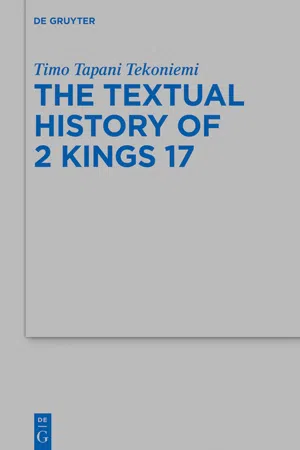
- 323 pages
- English
- ePUB (mobile friendly)
- Available on iOS & Android
The Textual History of 2 Kings 17
About this book
The textual history of the Books of Kings forms one of the most complex and debated issues in the modern text-historical scholarship. This book examines and reconstructs the textual history of 2 Kings 17 in light of the preserved textual evidence. The analysis of textual differences between the LXX, the Old Latin, and the MT allows the reconstruction of the oldest text attainable. The Old Latin version appears to have in many cases best preserved the Old Greek edition of the chapter, now lost in the Greek witnesses due to Hebraizing revisions. The Old Greek version of 2 Kings 17 evidences a Hebrew Vorlage often radically differing from the MT. In most cases the MT exhibits signs of later editing. The LXX can thus help the scholars reconstruct multiple text-historical layers previously out of our reach, as well as shed new light on certain historiographical details recounted in 2 Kings 17. As supposed by the literary critics for well over a century, the textual data shows beyond doubt that there happened vast editing and rewriting of the Books of Kings even at very late date. Text-critical considerations are therefore not only useful, but invaluable to all scholarly work on 2 Kings 17, and the Books of Kings as a whole.
Frequently asked questions
- Essential is ideal for learners and professionals who enjoy exploring a wide range of subjects. Access the Essential Library with 800,000+ trusted titles and best-sellers across business, personal growth, and the humanities. Includes unlimited reading time and Standard Read Aloud voice.
- Complete: Perfect for advanced learners and researchers needing full, unrestricted access. Unlock 1.4M+ books across hundreds of subjects, including academic and specialized titles. The Complete Plan also includes advanced features like Premium Read Aloud and Research Assistant.
Please note we cannot support devices running on iOS 13 and Android 7 or earlier. Learn more about using the app.
Information
1 Introduction
1.1 The outline and aims of this study
1.2 Methodological considerations
1.2.1 In the search for “documented evidence”
Table of contents
- Title Page
- Copyright
- Contents
- 1 Introduction
- 2 The textual history of verses 1–23 in light of documented evidence
- 3 Literary and redactional analysis of verses 7–23
- 4 The textual history of verses 24–41
- 5 Conclusions: the textual history of 2Kgs 17
- Abbreviations
- Bibliographical abbreviations
- Hebrew Bible
- Qumran
- Other Ancient Sources
- Index of Modern Authors
- Subject index